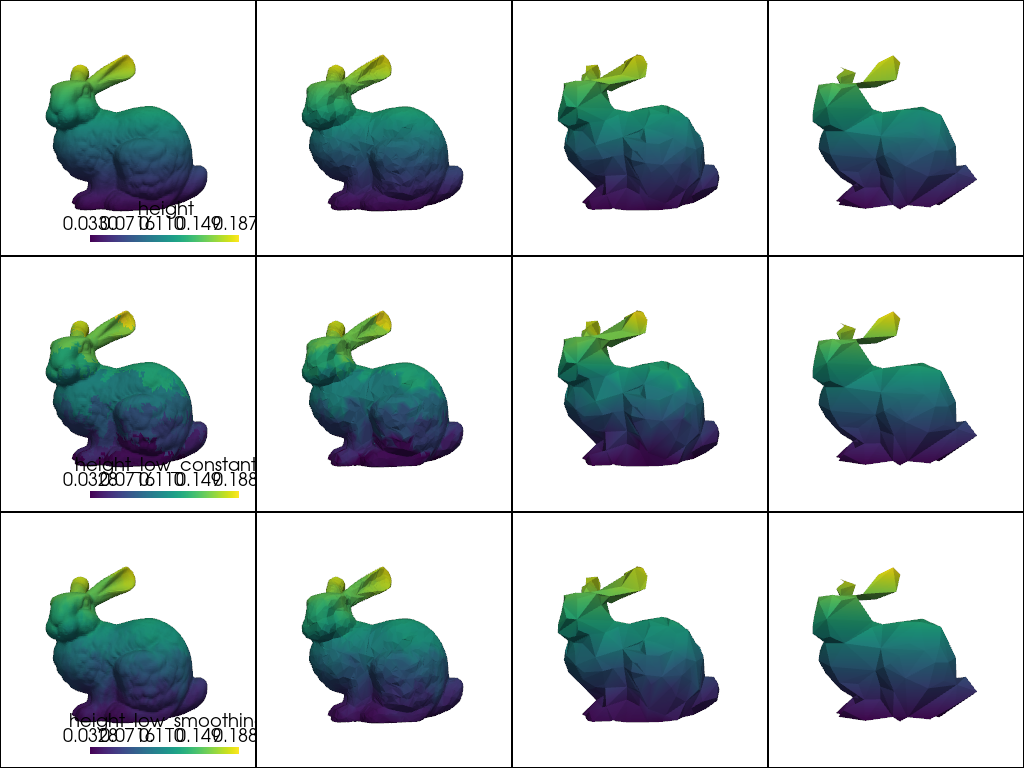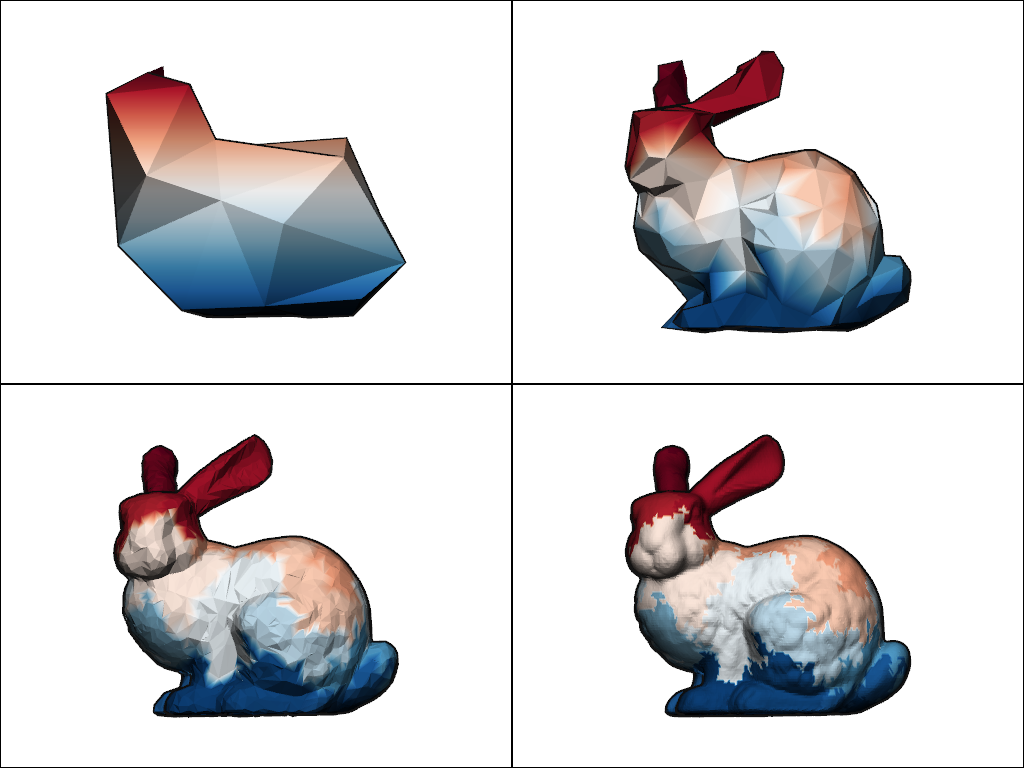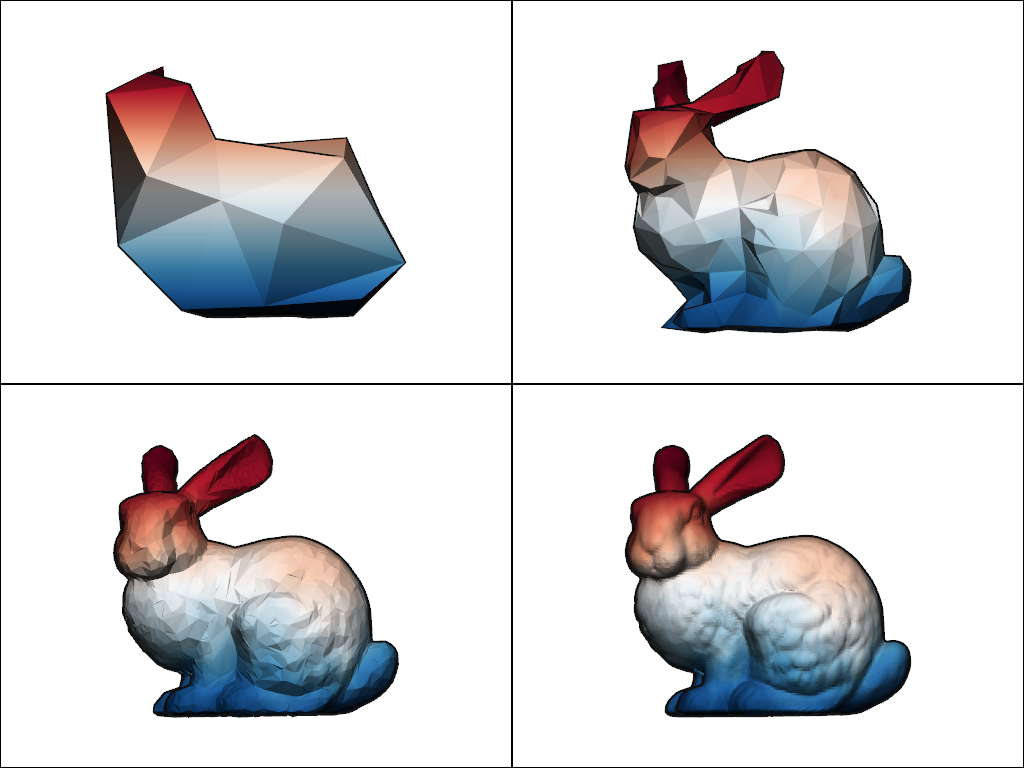Note
Go to the end to download the full example code
Multiscaling and signal propagation
We propagate a signal across the different shapes of a multiscale representation,
using rules that are specified by a FineToCoarsePolicy
and a CoarseToFinePolicy.
First, we load the Stanford bunny as a triangle mesh and sub-sample it using 10%, 1% and 0.5% of the original point count.
import pyvista as pv
import skshapes as sks
bunny = sks.PolyData(pv.examples.download_bunny())
ratios = [1, 0.1, 0.01, 0.001]
multiscale_bunny = sks.Multiscale(shape=bunny, ratios=ratios)
Then, we define a signal on the original, high resolution surface mesh.
# Extract the 2nd coordinate "y" of each point "xyz"
signal = multiscale_bunny.at(ratio=1).points[:, 1]
# Use it as a "height" signal
multiscale_bunny.at(ratio=1).point_data["height"] = signal
We use the propagate()
method to transfer the signal from our high resolution mesh to the coarser scales.
Note
Accessing the multiscale representation at ratio=1 always returns the finest shape.
multiscale_bunny.propagate(
signal_name="height",
from_ratio=1,
fine_to_coarse_policy=sks.FineToCoarsePolicy(reduce="mean"),
)
pl = pv.Plotter(shape=(2, 2))
for i, ratio in enumerate(ratios):
pl.subplot(i // 2, i % 2)
sks.doc.display(
plotter=pl, shape=multiscale_bunny.at(ratio=ratio), scalars="height"
)
pl.show()

Conversely, let us propagate a signal from the coarser resolutions to the finer levels of detail.
Note
Accessing the multiscale representation at ratio=0 always returns the coarsest shape.
signal_coarse = multiscale_bunny.at(ratio=0).points[:, 1]
multiscale_bunny.at(ratio=0).point_data["signal"] = signal_coarse
# propagate the signal from the lower resolutions to the higher resolution
multiscale_bunny.propagate(
signal_name="signal",
from_ratio=0,
coarse_to_fine_policy=sks.CoarseToFinePolicy(smoothing="constant"),
)
pl = pv.Plotter(shape=(2, 2))
for i, ratio in enumerate(reversed(ratios)):
pl.subplot(i // 2, i % 2)
sks.doc.display(
plotter=pl, shape=multiscale_bunny.at(ratio=ratio), scalars="signal"
)
pl.show()

The "constant" policy results in sharp transitions between regions of
the surface that were collapsed to the same coarse point.
To mitigate this issue, we can use a "mesh_convolution" CoarseToFinePolicy
that interleaves smoothing steps between the jumps from coarse to fine scales.
multiscale_bunny.propagate(
signal_name="signal",
from_ratio=0,
coarse_to_fine_policy=sks.CoarseToFinePolicy(
smoothing="mesh_convolution",
n_smoothing_steps=2,
),
)
pl = pv.Plotter(shape=(2, 2))
for i, ratio in enumerate(reversed(ratios)):
pl.subplot(i // 2, i % 2)
sks.doc.display(
plotter=pl, shape=multiscale_bunny.at(ratio=ratio), scalars="signal"
)
pl.show()

Total running time of the script: (0 minutes 3.743 seconds)